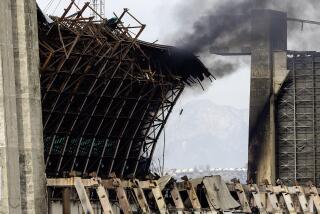Navy to mask barracks shaped like a swastika
- Share via
CORONADO, Calif. -- The U.S. Navy has decided to spend as much as $600,000 for landscaping and architectural modifications to obscure the fact that one its building complexes looks like a swastika from the air.
The four L-shaped buildings, constructed in the late 1960s, are part of the amphibious base at Coronado and serve as barracks for Seabees.
From the ground and from inside nearby buildings, the controversial shape cannot be seen. Nor are there any civilian or military landing patterns that provide such a view to airline passengers.
But once people began looking at satellite images from Google Earth, they started commenting on blogs and websites about how much the buildings resembled the symbol used by the Nazis.
When contacted by a Missouri-based radio talk-show host last year, Navy officials gave no indication they would make changes.
But early this year, the issue was quietly taken up by Morris Casuto, the Anti-Defamation League’s regional director in San Diego, and U.S. Rep. Susan Davis (D-San Diego).
As a result, in the fiscal year that begins Oct. 1, the Navy has budgeted up to $600,000 for changes in walkways, “camouflage” landscaping and rooftop photovoltaic cells.
The goal is to mask the shape. “We don’t want to be associated with something as symbolic and hateful as a swastika,” said Scott Sutherland, deputy public affairs officer for Navy Region Southwest, the command that is responsible for maintaining buildings on local bases.
The collection of L-shaped buildings is at the corner of Tulagi and Bougainville roads, named after World War II battles.
Navy officials say the shape of the buildings, designed by local architect John Mock, was not noted until after the groundbreaking in 1967 -- and since it was not visible from the ground, a decision was made not to make any changes.
It is unclear who first noticed the shape on Google Earth. But one of the first and loudest advocates demanding a change was Dave vonKleist, host of a Missouri-based radio-talk show, The Power Hour, and a website, www.thepowerhour.com.
In spring 2006, he began writing military officials, including then-Defense Secretary Donald H. Rumsfeld, calling for action.
That August, he received a response from officials in Coronado, who made no promise to take action and said, “The Navy intends to continue the use of the buildings as long as they remain adequate for the needs of the service.”
In December, the now-defunct San Diego Jewish Times wrote about the buildings and the controversy. Soon Casuto and Davis got involved.
Casuto began an on-and-off dialogue with the chief of staff to Rear Adm. Len Hering, commander of Region Southwest. He said that several members of the Jewish community had complained to him.
“I don’t ascribe any intentionally evil motives to this,” Casuto said, referring to the design. “It just happened. The Navy has been very good about recognizing the problem. The issue is over.”
Davis, who is Jewish, is also pleased with the Navy’s decision.
During a discussion with military officials on other issues, Davis had mentioned the Coronado buildings and suggested that rooftop photovoltaic arrays might help change the overhead look. The base gets 3% of its power from solar energy and has been looking to increase that percentage.
Reached in Versailles, Mo., VonKleist, the talk-show host, said he was ecstatic.
“I’m concerned about symbolism,” he said. “This is not the type of message America needs to be sending to the world.”
--
More to Read
Sign up for Essential California
The most important California stories and recommendations in your inbox every morning.
You may occasionally receive promotional content from the Los Angeles Times.






